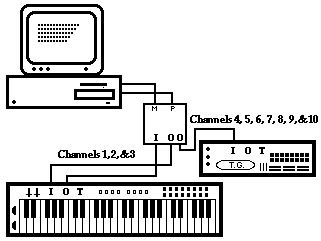

All MIDI devices receive MIDI information at the MIDI In port. All MIDI channel message information has an identification of a specific MIDI channel. The second nibble of a MIDI byte has sixteen possibilities that identify the MIDI channel. In the example below, the first four digits (1100) represent a program change and the last four digits (1111), refer to MIDI channel 16.
| Binary code | 11001111 |
| Hexadecimal | C F |
Consider the analogy of a television set that has sixteen channels. All
sixteen may be viewed, but only one channel may be on the screen at any
given moment. A MIDI device may be set-up to respond in a similar fashion.
It may receive information on all sixteen channels, but it only responds
to one MIDI channel at time. The MIDI device will ignore all channel messages
that do not correspond to the same MIDI channel. This type of reception
mode is called Omni-Off Poly. Now, let's look at the four types of MIDI
reception modes.
![]() Return to MIDI Channels
& Modes Menu
Return to MIDI Channels
& Modes Menu
A multi-timbral MIDI device is able to respond to two or more different sounds simultaneously. It is like having two or more synthesizers combined into one device. A multi-timbral instrument can be set-up to play a piano sound on channel 1, a bass sound on channel two, a string sound on channel 3, and a solo instrument sound on channel 4. This type of device works well with a sequencer program that has specific information assigned to separate tracks, because each timbre ( program) will only respond to a specific MIDI channel.
 |
In the example on the left, a sequencer application in the computer can send multiple tracks of MIDI notes on channels 1 through 10. The keyboard is set-up to respond to MIDI information on channels 1 through 3, while the multi-timbral device on the right is responding to MIDI information on channels 4 through 10. |
![]() Return to MIDI
Channels & Modes Menu
Return to MIDI
Channels & Modes Menu